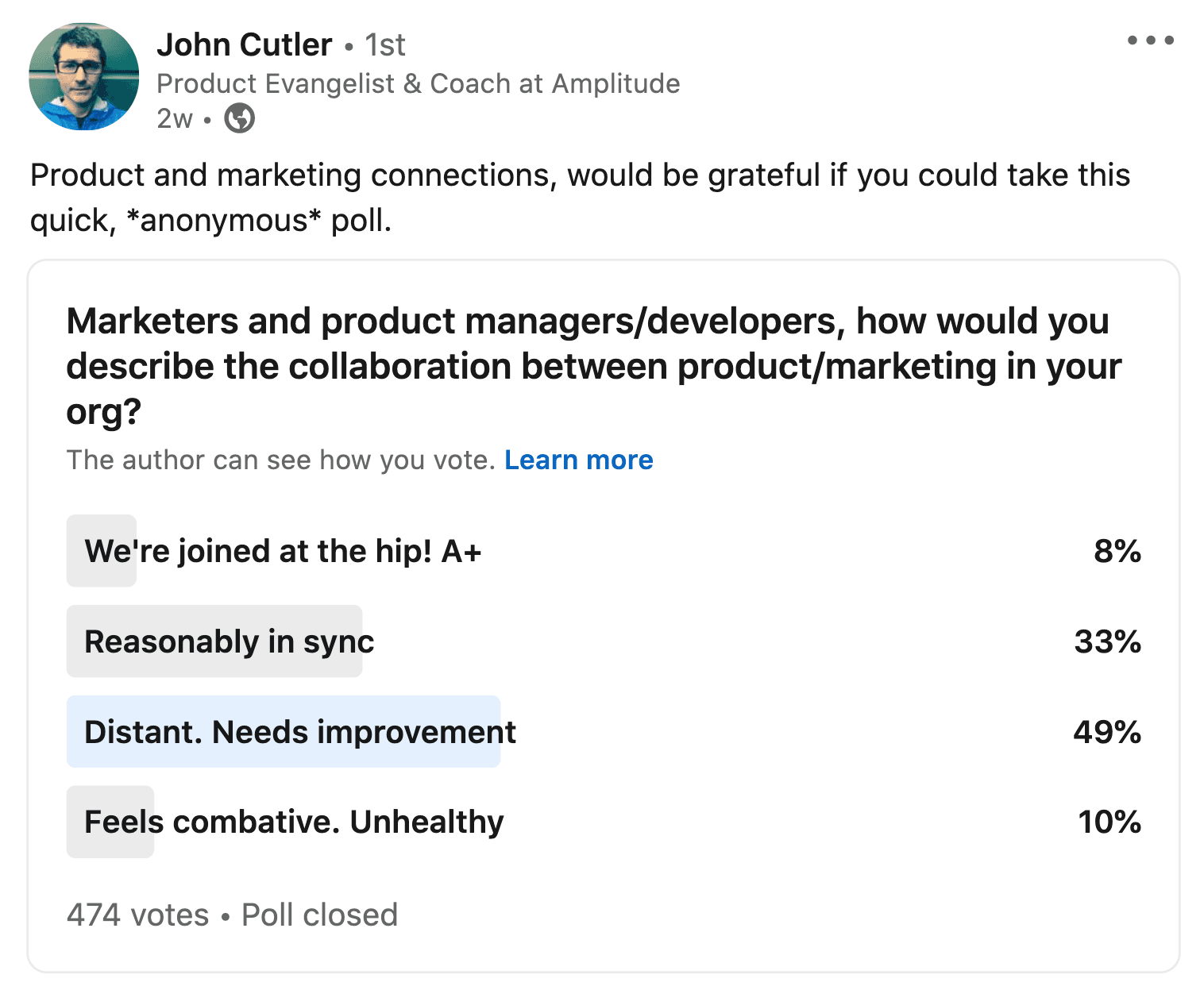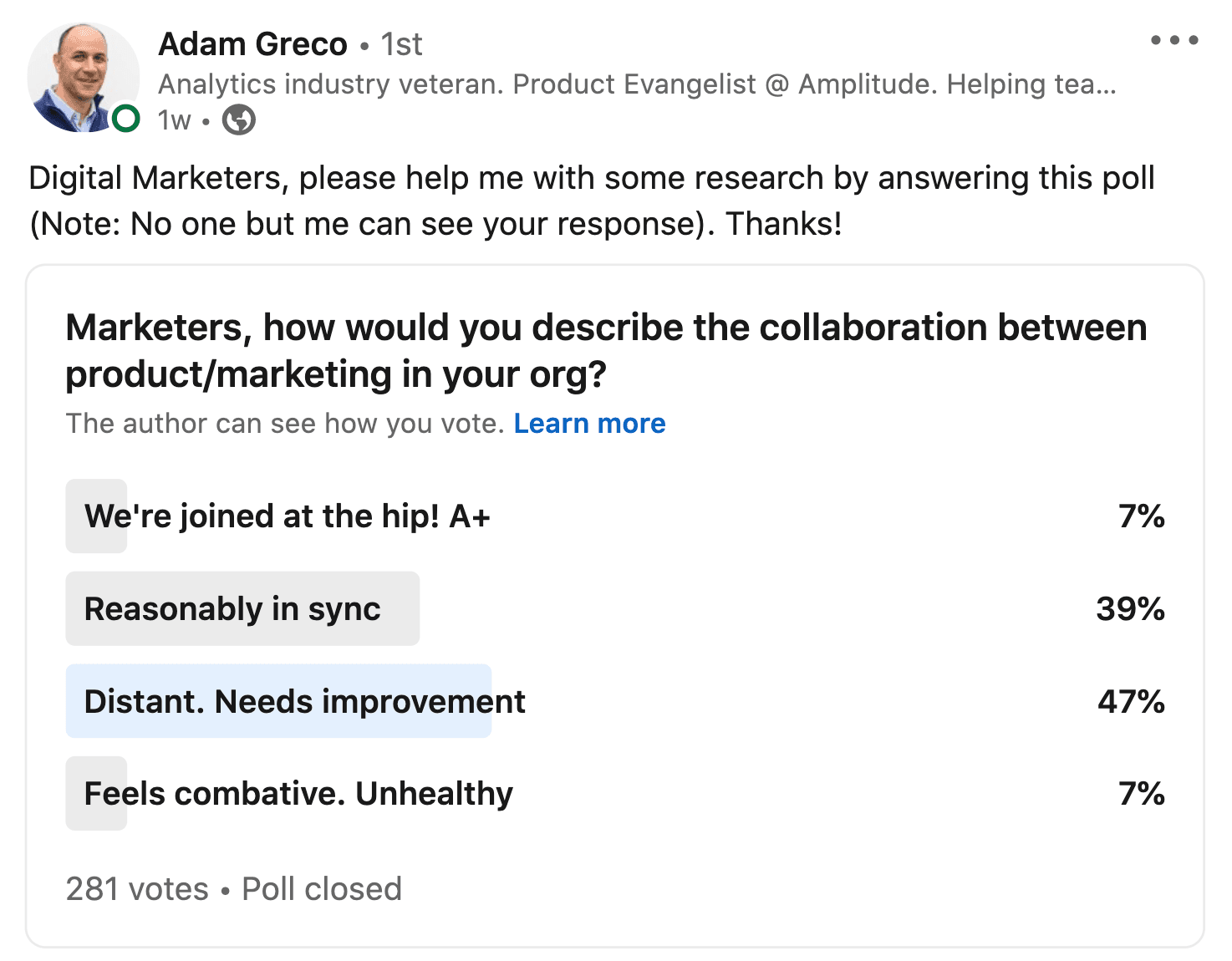Why Product and Marketing Need to Collaborate
Analytics can be a great mechanism to foster collaboration.
A True Story
Over a decade ago, when I worked as director of analytics at Salesforce, my main responsibility was to leverage data to increase sales leads. I was part of the marketing team and we used SEO, paid search, email, social media and testing to build the pipeline. The main call to action on our website was conducting a free trial of the Salesforce CRM product. No matter how you got there or what you did, you would be prompted to start a free trial. We used a digital marketing analytics product to track what content helped get visitors to begin a trial, marketing channel performance and cost per lead.
Once prospects began a free trial, however, our team had zero visibility into what happened. The product team was responsible for analyzing what prospects did in the free trial. The product team chose not to use the same digital marketing analytics product within the authenticated free trial experience, but rather, used a more product-focused analytics tool. Eventually, when the free trial was over, our team would get a report of which prospects became customers and which did not. In order to understand the cost per customer, we had to use complex database lookups to try and match the converted customers to those who began the free trial. This process was overly complex and not very reliable.
After some failed attempts to fight against corporate structures and technology challenges, our marketing team was ultimately unable to convince the product team that we should collaborate on the free trial process. If we had used one analytics platform for the marketing and free trial portions of the visitor journey, it would have been much easier to see how marketing campaigns led to trials and ultimately conversions. Unfortunately, even more than a decade later, the same problems are prevalent.
Some Informal Analysis
As I mentioned when I joined Amplitude, I continue to see a lack of cooperation between marketing and product teams. In fact, these teams often live in completely different worlds. Since I am a data person, here are some data points to validate my hypothesis.
John Cutler, my colleague here at Amplitude, is one of the foremost experts in the product world. Before I joined Amplitude I hadn’t been familiar with him and his breadth of product-based content. And I am not alone. I have about 17,000 LinkedIn connections and most of those are digital marketing folks based upon my 20-year career in that field. John has even more connections, who are mostly product folks. So I compared our two networks and found that we had less than 350 mutual connections. And when I excluded those who work at Amplitude, it turned out that we had only 87 mutual connections! This means that only 0.5% of my connections are reading his product content and vice versa for my marketing content.
Hungry for more data around the overlap between product and marketing, John launched a poll to his LinkedIn product followers asking how they collaborate with marketing. Here are the results:

I ran the same poll to my followers and got the following results:

As you can see, the results are pretty consistent and it is clear that product and marketing teams are not collaborating at a very high level.
Why Should Product and Marketing Collaborate?
So why should product teams and marketing teams collaborate? As more and more businesses digitally transform, it is often the digital experience that determines whether they will select and become loyal to your product. Customers don’t care about your corporate org chart. They don’t care that product and marketing are on different teams. They simply want a good experience from beginning to end.
If we use the aforementioned Salesforce scenario, here are some ways that better collaboration between product and marketing could have helped:
- Marketing had data indicating that those coming from SEO and paid search were less familiar with Salesforce and CRM than those who had previously attended webinars or in-person Salesforce events. The product team could use this information to educate prospects differently during the free trial on-boarding process. For example, those new to Salesforce could be provided with more information about the company and CRM in general throughout the free trial experience.
- If prospects conducting a free trial stopped engaging, the product team could have sent IDs of non-responsive users to marketing so that they could attempt to re-engage them via various marketing channels.
- During the free trial, the product team could identify the product features most used by prospects and which features most often led to conversion. By learning what product features get prospects to the “Aha” or “key value exchange” moment, the marketing team could then use this information to improve its website content around those features and to highlight those features in marketing acquisition campaigns.
- If product and marketing were using the same analytics platform for both the marketing and product experiences, it would be possible to see the complete prospect journey to see where drop-off takes place from the very first touch all the way to the final conversion. This would help identify key points of disengagement that could be fixed with new content or support.
- If marketing were able to see the full prospect journey, it would be able to better identify which marketing channels, campaigns and creative elements led to the most conversion instead of just seeing what led to free trials. Without this, they wouldn’t be optimizing for the correct KPI.
- When it comes time for renewal, or much further down the “funnel,” product and marketing collaboration would allow the organization to see which channels were producing higher customer lifetime value. As free trial customers convert and either expand usage or churn, the combined data set becomes more valuable over time as the organization can see which marketing campaigns lead to long-term value.
What Is Preventing Product and Marketing Collaboration?
As is often the case, getting these two teams to collaborate involves people, process and technology. The members of these teams have to see the value in collaborating. Putting the customer front and center and having a common goal can help. Breaking down some of the departmental silos between the two teams or creating cross-functional teams can help. And, yes, using a common analytics platform between the two teams can help. Analytics products serve as a common language that both teams can understand and rally around. While nothing about getting product and marketing teams to collaborate is easy, at a practical level, getting both teams to use the same digital analytics product is one of the least difficult steps that can be taken.
As I have mentioned in previous posts, I often see organizations using one analytics product on the website and another product behind the authenticated area or mobile app, as was the case in the Salesforce example. Given the convergence of digital analytics tools, this is no longer necessary. Using separate analytics products (e.g. one for the website and another for the mobile app) creates artificial barriers and opens the door for each group having its own set of data. More time is spent arguing over whose data is correct instead of having one agreed upon data set.
I wouldn’t have joined Amplitude if I didn’t feel that product analytics data, that which takes place within the product experience itself, were the most valuable. While I will always appreciate how important it is to acquire new customers, I think that how customers experience your digital product (website or mobile app) is what ultimately determines value creation for both the customer and the organization. That is why I recommend making the unified analytics platform used by both product and marketing be one that focuses on product digital optimization.
Product and Marketing Team Workshops!
Being both disappointed and inspired by the survey results shown above, John Cutler and I are now offering a first of its kind Product & Marketing Team Collaboration workshop in which we bring your product and marketing teams together to dig deeper on this topic and come up with tangible examples on how collaboration can be increased. With John’s vast network of product folks and my network of marketing folks, we think we are in a unique position to tackle this industry-wide problem. Our virtual workshop is highly engaging and will help your teams to confront some of the issues blocking effective collaboration.
If you would like to chat with us about having us conduct this workshop for your organization, use this link to schedule an initial chat with John and I. Thanks!

Adam Greco
Former Product Evangelist, Amplitude
Adam Greco is one of the leading voices in the digital analytics industry. Over the past 20 years, Adam has advised hundreds of organizations on analytics best practices and has authored over 300 blogs and one book related to analytics. Adam is a frequent speaker at analytics conferences and has served on the board of the Digital Analytics Association.
More from Adam





